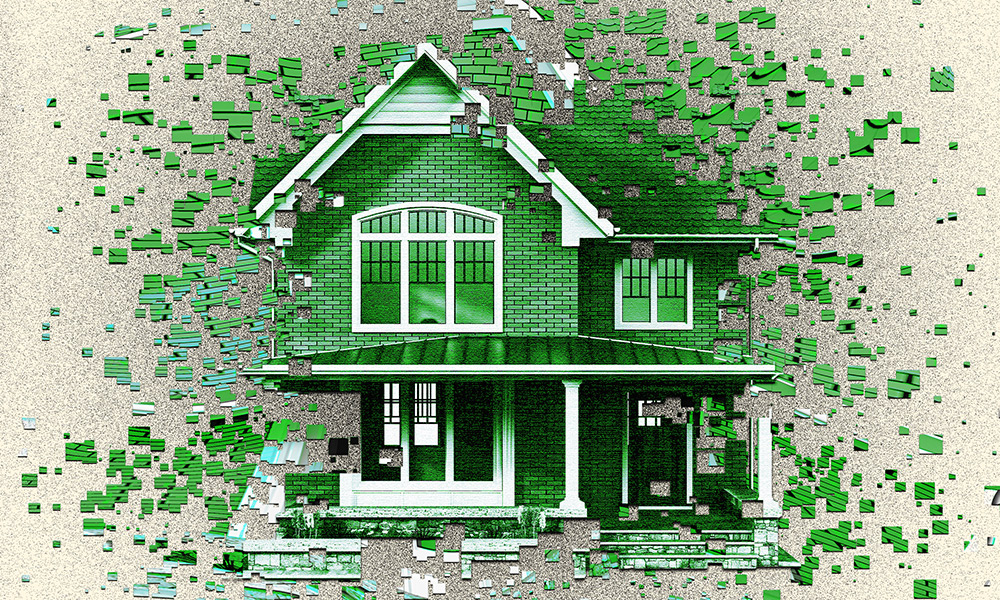
迄今为止,万亿富翁还没有诞生。但万亿美元大都市呢?它们确实存在,而且数量越来越多。
去年,美国万亿美元都市的数量翻了一番,从4个增加到8个。纽约、洛杉矶、亚特兰大和波士顿早已加入老牌万亿美元都市俱乐部,这意味着它们的房屋总价值超过万亿美元。Redfin上周四发布的一份分析报告显示,阿纳海姆、芝加哥、凤凰城和华盛顿特区,也加入了万亿美元都市俱乐部。Redfin分析了美国大部分地区超过9,500万套住宅及其截至6月的价值(该公司表示,可能对数据进行修正)。
还有两个大都市可能很快进入万亿美元都市的行列,它们是圣迭戈和西雅图。旧金山无法上榜,因为其房屋总价值约为7,000亿美元。但如果加上奥克兰和圣何塞,它们的总价值接近2.5万亿美元。同样,达拉斯和沃斯堡的房屋价值合计也超过1万亿美元。
大都市的房屋价值取决于多个因素,例如房屋数量、总房屋面积、基本房价等。例如:凤凰城和洛杉矶都是万亿美元都市,尽管凤凰城的平均房价远低于洛杉矶。洛杉矶人口更多,但凤凰城的房屋面积略高于洛杉矶。
去年,美国的房屋总价值增长超过3万亿美元,使房地产市场的价值接近50万亿美元,创历史新高。据Redfin统计,过去10年,房屋总价值增长了超过一倍。背后的原因并非秘密:疫情期间房价暴涨,而且现在依旧在上涨,尽管上涨速度有所放缓。归根结底原因在于供应问题。美国房屋供应不足的原因是房屋建设量不足和利率锁定效应,尽管后者会有所缓解。由于疫情期间抵押贷款利率极低,出现了锁定效应,但随着利率突然升高,购房人受到了价格冲击。相对而言,去年的抵押贷款利率并不是特别高,更未达到闻所未闻的程度。另一方面,数百万套房屋缺口依旧存在。
Redfin经济研究主管赵晨(音译)表示:“由于待售房屋数量不足以降低房价,因此美国房地产市场的价值将在未来12个月突破50万亿美元大关。”
但抵押贷款利率持续下降,房价上涨速度放缓,而且随着市场再平衡房屋库存持续增多,有些地区也在增加房屋建设,足以满足需求。在房地产市场价值涨幅最大的10个都市区中,有2个位于加州(阿纳海姆和圣何塞);在涨幅最小的10个都市区中,有6个位于德克萨斯州(奥斯汀、沃斯堡、埃尔帕索、麦卡伦、休斯顿和圣安东尼奥)。德克萨斯州的房屋建设量远高于加州,因为在德克萨斯州建设房屋更容易,这是阳光地带的新兴都市房地产市场降温的原因。
房屋价值上涨的其他都市区位于新泽西州,这里靠近纽约市,按照Redfin的说法是“在房价更高的纽约市通勤距离以内、房价相对较低的新泽西州都市区”。这可能表明远程办公或混合办公依旧流行,或者超长途通勤的情况依旧存在。
此外,Redfin的分析还显示,在郊区有约5,700万套住宅,在城区有2,200万套住宅,农村地区有2,100万套住宅。尽管如此,去年农村房价上涨速度却超过其他两个类别,但“郊区房屋的价值首次突破30万亿美元。”城区房屋的价值超过10万亿美元,而农村房屋的价值不到8万亿美元。
最后,有一些对千禧一代来说的好消息:第一季度,千禧一代拥有的房屋总价值同比增长21.5%,达到约9万亿美元。这个增长速度是其他任何一代人的四倍。分析报告称:“增长的部分原因是房价上涨,另外一个原因是千禧一代是目前人口最多的一代人,并且到了买房的年龄和财务状况,因此他们在购房市场中占据了更大份额。”但不出所料,婴儿潮一代依旧是最富有的一代人,而且他们的房屋价值更高。(财富中文网)
译者:刘进龙
审校:汪皓
迄今为止,万亿富翁还没有诞生。但万亿美元大都市呢?它们确实存在,而且数量越来越多。
去年,美国万亿美元都市的数量翻了一番,从4个增加到8个。纽约、洛杉矶、亚特兰大和波士顿早已加入老牌万亿美元都市俱乐部,这意味着它们的房屋总价值超过万亿美元。Redfin上周四发布的一份分析报告显示,阿纳海姆、芝加哥、凤凰城和华盛顿特区,也加入了万亿美元都市俱乐部。Redfin分析了美国大部分地区超过9,500万套住宅及其截至6月的价值(该公司表示,可能对数据进行修正)。
还有两个大都市可能很快进入万亿美元都市的行列,它们是圣迭戈和西雅图。旧金山无法上榜,因为其房屋总价值约为7,000亿美元。但如果加上奥克兰和圣何塞,它们的总价值接近2.5万亿美元。同样,达拉斯和沃斯堡的房屋价值合计也超过1万亿美元。
大都市的房屋价值取决于多个因素,例如房屋数量、总房屋面积、基本房价等。例如:凤凰城和洛杉矶都是万亿美元都市,尽管凤凰城的平均房价远低于洛杉矶。洛杉矶人口更多,但凤凰城的房屋面积略高于洛杉矶。
去年,美国的房屋总价值增长超过3万亿美元,使房地产市场的价值接近50万亿美元,创历史新高。据Redfin统计,过去10年,房屋总价值增长了超过一倍。背后的原因并非秘密:疫情期间房价暴涨,而且现在依旧在上涨,尽管上涨速度有所放缓。归根结底原因在于供应问题。美国房屋供应不足的原因是房屋建设量不足和利率锁定效应,尽管后者会有所缓解。由于疫情期间抵押贷款利率极低,出现了锁定效应,但随着利率突然升高,购房人受到了价格冲击。相对而言,去年的抵押贷款利率并不是特别高,更未达到闻所未闻的程度。另一方面,数百万套房屋缺口依旧存在。
Redfin经济研究主管赵晨(音译)表示:“由于待售房屋数量不足以降低房价,因此美国房地产市场的价值将在未来12个月突破50万亿美元大关。”
但抵押贷款利率持续下降,房价上涨速度放缓,而且随着市场再平衡房屋库存持续增多,有些地区也在增加房屋建设,足以满足需求。在房地产市场价值涨幅最大的10个都市区中,有2个位于加州(阿纳海姆和圣何塞);在涨幅最小的10个都市区中,有6个位于德克萨斯州(奥斯汀、沃斯堡、埃尔帕索、麦卡伦、休斯顿和圣安东尼奥)。德克萨斯州的房屋建设量远高于加州,因为在德克萨斯州建设房屋更容易,这是阳光地带的新兴都市房地产市场降温的原因。
房屋价值上涨的其他都市区位于新泽西州,这里靠近纽约市,按照Redfin的说法是“在房价更高的纽约市通勤距离以内、房价相对较低的新泽西州都市区”。这可能表明远程办公或混合办公依旧流行,或者超长途通勤的情况依旧存在。
此外,Redfin的分析还显示,在郊区有约5,700万套住宅,在城区有2,200万套住宅,农村地区有2,100万套住宅。尽管如此,去年农村房价上涨速度却超过其他两个类别,但“郊区房屋的价值首次突破30万亿美元。”城区房屋的价值超过10万亿美元,而农村房屋的价值不到8万亿美元。
最后,有一些对千禧一代来说的好消息:第一季度,千禧一代拥有的房屋总价值同比增长21.5%,达到约9万亿美元。这个增长速度是其他任何一代人的四倍。分析报告称:“增长的部分原因是房价上涨,另外一个原因是千禧一代是目前人口最多的一代人,并且到了买房的年龄和财务状况,因此他们在购房市场中占据了更大份额。”但不出所料,婴儿潮一代依旧是最富有的一代人,而且他们的房屋价值更高。(财富中文网)
译者:刘进龙
审校:汪皓
No trillionaires exist, not yet. But trillion-dollar metropolitan areas? They exist, and they’re multiplying.
In the last year, the number of trillion-dollar metros doubled, from four to eight. New York, Los Angeles, Atlanta, and Boston were already in the trillion-dollar club, meaning their total value of homes totaled more than a trillion dollars. They were joined by Anaheim, Chicago, Phoenix, and Washington, D.C., according to an analysis from Redfin published Thursday that looked at more than 95 million residential properties and their home values in most parts of the country as of June (the data is subject to revision, it said).
Two more metros could make the cut soon: San Diego and Seattle. You won’t see San Francisco on the list since its total value of homes comes to about $700 billion. Still, when it’s coupled with Oakland and San Jose, their total is worth close to $2.5 trillion. Similarly, home values in Dallas and Fort Worth, combined, equal more than a trillion dollars.
For what it’s worth, there are several variables at play, such as number of homes, total area in square miles, typical home prices, etc. Consider this: Phoenix and Los Angeles are both trillion-dollar cities, even though Phoenix’s average home value is considerably lower than L.A.’s. Los Angeles also has a greater population, but the area of Phoenix is slightly larger.
In the past year, the total sum of homes in the country increased by slightly more than $3 trillion, pushing the housing market’s worth to an all-time high: close to $50 trillion. In the past decade, the total value of homes has more than doubled, according to Redfin. It’s no secret why: Home prices exploded during the pandemic, and they’re still on the rise, albeit more slowly. And it all comes down to supply. There aren’t enough homes because of underbuilding and the lock-in effect, although the latter will relent. The phenomenon is occurring only because mortgage rates were so low during the pandemic that once they rose suddenly, the pain of sticker shock ensued. Relatively speaking, mortgage rates in the last year or so aren’t wildly high or even unheard of. The shortfall of homes in the millions, on the other hand, is lasting.
“The value of America’s housing market will likely cross the $50 trillion threshold in the next 12 months as there are not enough homes being listed to push prices down,” said Chen Zhao, economics research lead at Redfin.
But mortgage rates are falling, home price inflation is slowing, and inventory is increasing as the market rebalances—and some places are building more homes, too, enough to meet demand. Two of the 10 metros that saw the greatest leaps in value were in California (Anaheim and San Jose); six of the 10 metros that saw the smallest increase in value were in Texas (Austin, Fort Worth, El Paso, McAllen, Houston, and San Antonio). The Lone Star State builds many more homes than the Golden State, because it’s easier to do so, and it’s why Sunbelt boomtowns are cooling off.
Some other metropolitan areas that saw home values swell were in New Jersey, close to New York City—or, as Redfin put it, “relatively-affordable New Jersey metros within commuting distance of New York, where property is more expensive.” It could be an indication that remote, or hybrid, work is alive and well, or that super-commuting is still a thing.
Separately, another thread from Redfin’s analysis showed there are around 57 million homes in the suburbs, 22 million in urban areas, and 21 million in rural areas. Even so, rural home values rose faster than the other two categories in the last year, but “the value of homes in the suburbs cracked the $30 trillion mark for the first time.” Home values in urban areas are worth more than $10 trillion, and those in rural areas are worth under $8 trillion.
And lastly, some sort of good news for millennials: The total value of homes owned by the generation rose 21.5% from a year earlier to almost $9 trillion in the first quarter. That’s four times as fast as any other generation. “The increase is partly due to the overall growth in home prices, but also because millennials are now the largest generation by population and have reached an age and financial position where they make up a larger share of the homebuying market,” the analysis read. But as you might expect, baby boomers are still the richest generation and their homes are worth much more.






